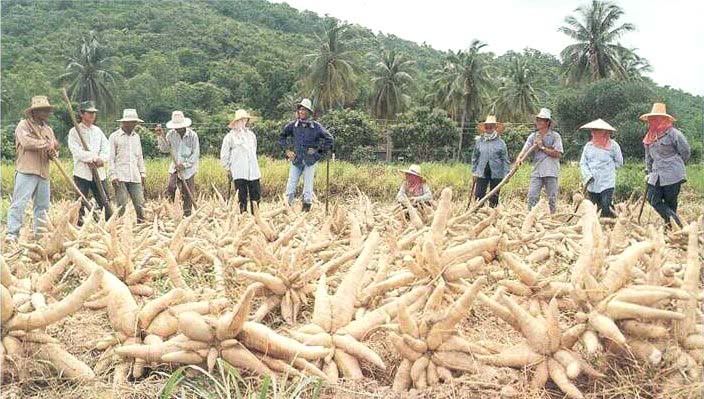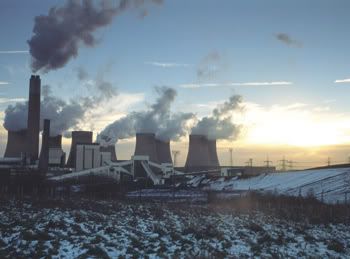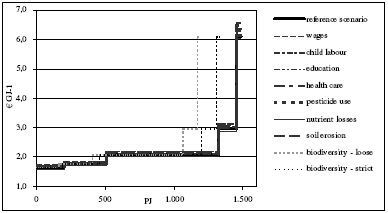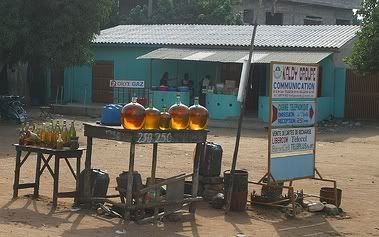Japan helps build Vietnam's first ethanol plant - cassava feedstock
 The Vietnamese Petroleum Services and Tourism Company (Petrosetco) and Japan's Itochu Co-operation will set up a joint venture to build a bio-ethanol plant, the first of its kind in Vietnam. The two partners signed a Memorandum of Understanding on the issue in Ho Chi Minh City on March 9.
The Vietnamese Petroleum Services and Tourism Company (Petrosetco) and Japan's Itochu Co-operation will set up a joint venture to build a bio-ethanol plant, the first of its kind in Vietnam. The two partners signed a Memorandum of Understanding on the issue in Ho Chi Minh City on March 9.The €76.2/US$100 million project will turn out 100 million litres (26.4 million gallons) of ethanol each year, from cassava chips, which will be sold in Vietnam to mix in petrol used in industrial production and transport activities.
The mixing of ethanol in petrol will help the country reduce its petrol imports as well as cut environmental pollution, said Tran Cong Tao, Petrosetco's chief of executive.
It is estimated that if a 10 percent ethanol ratio is introduced in the country's largest city, Ho Chi Minh City, some 100 to 150 million liters will be needed per year. This amount can be covered by the single plant.
The Itochu group has 30 years of experience handling ethanol projects and is willing share its knowledge with the Vietnamese partner to contribute to the first bio-ethanol project in Vietnam, according to Itochu's deputy executive director Toshio Shigemi.
Deputy Minister of Industry Do Huu Hao and Vice Chairman of the municipal People's Committee Nguyen Trung Tin spoke highly of the co-operation between Petrosetco and Itochu to create a new kind of energy for Vietnam. The two officials also pledged to assist the project and expressed hope that the plant will soon be operational:
 biomass :: bioenergy :: biofuels :: energy :: sustainability :: ethanol :: cassava :: Japan :: Vietnam ::
biomass :: bioenergy :: biofuels :: energy :: sustainability :: ethanol :: cassava :: Japan :: Vietnam :: Construction of the plant, which will be located in the Hiep Phuoc industrial zone, is expected to be completed in the first quarter of 2009.
Cassava is being used accross South East Asia as a suitable feedstock for ethanol production. The starch-rich root crop is currently utilized in China and Thailand on an industrial scale.
Thailand recently launched a program involving smallholders who will be growing cassava for ethanol, in a push to alleviate poverty by diversifying their crop portfolio and open new markets (earlier post).
Likewise, in China, cassava is seen as an important crop to use for the production of biofuels instead of the grain crops many producers currently rely on. The fact that the plant requires low water and fertilizer inputs, and because it thrives on relatively poor soils, it is considered to be suitable for programs involving poor smallholders (earlier post).
Article continues
 --------------
--------------
 Taiwan's Feng Chia University has succeeded in boosting the production of hydrogen from biomass to 15 liters per hour, one of the world's highest biohydrogen production rates, a researcher at the university said Friday. The research team managed to produce hydrogen and carbon dioxide (which can be captured and stored) from the fermentation of different strains of anaerobes in a sugar cane-based liquefied mixture. The highest yield was obtained by the Clostridium bacterium.
Taiwan's Feng Chia University has succeeded in boosting the production of hydrogen from biomass to 15 liters per hour, one of the world's highest biohydrogen production rates, a researcher at the university said Friday. The research team managed to produce hydrogen and carbon dioxide (which can be captured and stored) from the fermentation of different strains of anaerobes in a sugar cane-based liquefied mixture. The highest yield was obtained by the Clostridium bacterium.

 The agreement between the U.S. and Brazil on advancing biofuels cooperation was lauded as a step towards a new paradigm that is set to transform the world's energy system in the 21st century.
The agreement between the U.S. and Brazil on advancing biofuels cooperation was lauded as a step towards a new paradigm that is set to transform the world's energy system in the 21st century. The long-awaited agreement between the U.S. and Brazil to cooperate on biofuels, was
The long-awaited agreement between the U.S. and Brazil to cooperate on biofuels, was  An international, EU-sponsored project has been launched to study the interactions between climate change and tropical peatlands which store up to 70 billion tonnes of carbon.
An international, EU-sponsored project has been launched to study the interactions between climate change and tropical peatlands which store up to 70 billion tonnes of carbon. At the European Council Summit, hosted by Germany which holds the rotating presidency of the European Union, heads of state of EU member-states have reached a historic agreement to adopt targets for renewables, biofuels and cutting greenhouse gas emissions.
At the European Council Summit, hosted by Germany which holds the rotating presidency of the European Union, heads of state of EU member-states have reached a historic agreement to adopt targets for renewables, biofuels and cutting greenhouse gas emissions. The head of Malaysia’s palm oil industry has called for a closer working relationship between the EU and the producers of vegetable oils used in biofuels.
The head of Malaysia’s palm oil industry has called for a closer working relationship between the EU and the producers of vegetable oils used in biofuels. Local energy player REWAG and the world's largest biogas firm Schmack Energie Holding's subsidiary
Local energy player REWAG and the world's largest biogas firm Schmack Energie Holding's subsidiary 
 British power firm Drax, the country's single biggest source of CO2 emissions,
British power firm Drax, the country's single biggest source of CO2 emissions,  Germany currently holds the rotating
Germany currently holds the rotating 



 As we progressively move towards the post-petroleum, bio-based economy, new breakthroughs in biotechnology become more frequent. The vision behind advocates of the bioeconomy is that all products derived from oil can and should gradually be replaced by biodegradable, efficient, climate neutral plant-based alternatives.
As we progressively move towards the post-petroleum, bio-based economy, new breakthroughs in biotechnology become more frequent. The vision behind advocates of the bioeconomy is that all products derived from oil can and should gradually be replaced by biodegradable, efficient, climate neutral plant-based alternatives. President Bush visits Brazil this week and is expected to hear President Lula lobbying him to end American ethanol tariffs. Brazil's push is now receiving the support from an unlikely quarter - the authoritative International Energy Agency (IEA), the independent energy adviser to 26 of the most industrialized nations.
President Bush visits Brazil this week and is expected to hear President Lula lobbying him to end American ethanol tariffs. Brazil's push is now receiving the support from an unlikely quarter - the authoritative International Energy Agency (IEA), the independent energy adviser to 26 of the most industrialized nations. After compre- hensive studies, a panel of the
After compre- hensive studies, a panel of the  Earlier this week, researchers identified which genes a bacterium activates to select the enzymes for the breakdown of cellulose into sugars. The discovery is important for the future of cellulosic ethanol production (
Earlier this week, researchers identified which genes a bacterium activates to select the enzymes for the breakdown of cellulose into sugars. The discovery is important for the future of cellulosic ethanol production (
 The imminence and severity of the problems posed by the accelerating changes in the global climate are becoming increasingly evident. Heat waves are becoming more severe, droughts and downpours are becoming more intense, the Greenland Ice Sheet is shrinking and sea level is rising, and the increasing acidification of the oceans is threatening calcifying organisms. The environment and the world’s societies are facing increasing stress.
The imminence and severity of the problems posed by the accelerating changes in the global climate are becoming increasingly evident. Heat waves are becoming more severe, droughts and downpours are becoming more intense, the Greenland Ice Sheet is shrinking and sea level is rising, and the increasing acidification of the oceans is threatening calcifying organisms. The environment and the world’s societies are facing increasing stress. A project between Brazil and Japan to help supply Brazilian ethanol made from sugarcane to the Japanese market could require a massive €6/US$8 billion in investments, Brazil's largest newspaper reported.
A project between Brazil and Japan to help supply Brazilian ethanol made from sugarcane to the Japanese market could require a massive €6/US$8 billion in investments, Brazil's largest newspaper reported. Brazil's biofuels sector has had a busy week again, with the launch of the International Biofuels Forum (
Brazil's biofuels sector has had a busy week again, with the launch of the International Biofuels Forum (






Saturday, March 10, 2007
New perspective on Amazonian population theories and the deforestation debate
Despite this encouraging news, an old scholarly debate keeps fuelling arguments about the historic nature of 'pristine' rainforests like that of the Amazon basin. These discussions in turn are used actively by both conservationists, farmers and loggers alike to legitimize their visions on issues such as the urgency with which biodiversity must be defended or the need for the absolute protection of forests.
Artificial or pristine landscape?
In the community of environmental archaeologists and paleo-ecologists, there are two distinct theories on pre-Columbian Amazonian populations. One commonly held vision says that the Amazon rainforest as it exists today is not 'pristine' at all, but basically an 'artificial landscape', created in ancient times by millions of people, who farmed, slashed-and-burned, logged and used the forests extensively and for centuries. According to the other camp, there is scant evidence for this hypothesis, and instead one can assume that the Amazon was sparsely populated, and only by small, primitive groups, whose impacts on the ecosystem have always been marginal.
Obviously, those with an interest in exploiting the forest today, point to the first theory and shamelessly argue that, since the Amazon has always been man-made and was massively disturbed in the past, there is no reason to stop humans from using it in the present.
Eurekalert now reports that the 'artificial landscape' view has become fashionable among many archaeologists and anthropologists, but that it is being challenged in a recent paper from Dr. Mark Bush of the Florida Institute of Technology. The findings of Bush's research may rekindle this debate which has had major implications for land use and policy-setting in the rainforest.
"We don't contradict that there were major settlements in key areas flanking the Amazon Channel -- there could have been millions of people living there," says Mark Bush, a British-born paleo-ecologist who travels to extremely remote rain forest locations to collect core samples from ancient lakes. He then analyzes those samples for pollen and charcoal and thus is able to conclude with a high degree of accuracy the extent of human settlement in that region.
"What we do say is that when you start to look away from known settlements, you may see very long-term local use," he says. "These people didn't stray very far from home, or from local bodies of water for several thousands of years. We looked at clusters of lakes and landscapes where people lived, and asked, did they leave their homesite to farm around other nearby lakes? No they didn't. These findings argue for a very localized use of Amazonian forest resources outside the main, known, archaeological areas."
Bush says the evidence comes from a geographically diverse area: three districts, each with 3 (in two cases) or four lakes. "In each we have one lake occupied and used, and the others little used or not used at all," he says. "So this is a total of 10 lakes that provide three separate instances -- one in Brazil, one in Ecuador and one in Peru, where there is evidence of long, continuous occupation of more than 5,000 years that did not spread to the adjacent, 8 to 10 kilometer distant lakes."
The findings are published in a paper titled "Holocene fire and occupation in Amazonia: records from two lake districts" that appears in a recent issue of Philosophical Transactions of the Royal Society of London B: Biological Sciences, the February edition of which is themed around "Biodiversity hotspots through time: using the past to manage the future". A wide variety of very interesting articles can be found in the issue, including one by Bruno Glaser titled "Prehistorically modified soils of central Amazonia: a model for sustainable agriculture in the twenty-first century", [*abstract] which deals with the ancient carbon-sequestration and soil enhancement technique known as 'terra preta', to which we referred earlier.
Bush says his paper, and another forthcoming in the journal Frontiers in Ecology and the Environment, may have important policy implications:
That's because the hypothesis of human-manufactured landscapes has been made popular by Charles Mann's book - 1491: New Revelations of the Americas Before Columbus - and could influence conservation policy in the Americas. That millions of people once populated the Americas, and that in Amazonia, at least, the rainforest is the product of long term human use, has been used as farmers and loggers as justification for clearcutting rainforests. Their argument, that the ecosystem already experienced vast landscape disturbance and proved resilient, relies on the ubiquitous influence of Pre-Columbian people, the suggestion that Bush's work rejects.
"These data are directly relevant to the resilience of Amazonian conservation, as they do not support the contention that all of Amazonia is a 'built landscape' and therefore a product of past human land use," Bush says. "Most archaeologists are buying into the argument that you had big populations that transformed the landscape en masse. Another group of archaeologists say that transformation was very much limited to river corridors, and if you went away from the river corridors there wasn't that much impact. That's what our findings tend to support."
Passionate debate
Bush doesn't expect that his new findings will settle the debate, however.
"There's just too much passion on this issue. People who are inclined to believe what we're talking about will say this is very strong evidence, and say 'let's have more.' The archaeologists will say this study only examines two districts."
Bush himself calls the paper, co-authored with Claudia Listopad, William D. Gosling, and Christopher Williams of Florida Tech, Paulo E. de Oliveira of Universidade do Guarulhos in Brazil, Miles R. Silman and Carolyn Krisel of Wake Forest and Mauro B. de Toledo of Florida Tech and Universidade Federal Fluminense in Brazil, an important first step in making the case, through core sampling and pollen and charcoal analysis of sediment from seven lake bottoms, three in one district, four in the other, that much of Amazonia has not been transformed by human actions, and ideally should be kept that way, to preserve species biodiversity.
"The way to see this is as a sneak peak," he says. "It's a new way to look at landscapes and it's a new tool. The study needs to be replicated in more places before people will be persuaded, but it's certainly a warning shot across the bow."
"While the majority of archaeologists argue the rivers were the major conduit for populations," he adds, "there is an increasing vocalization that there was much more widespread habitat transformation; that you still had a bulk of people along the river but their influence extended deep into the forest. It's still nebulous, and difficult to get people to map stuff, or put hard numbers on it, but there is a sentiment that the Amazonia has been disturbed and that the view of the Amazonian rainforest as a built landscape is gaining momentum. There are extremes at either ends, and the majority of people are in middle but there's a tendency of drifting toward the high end."
For example, he says 1950s population estimates were 1 million, in the 70s that estimate drifted up to 4 million; and in the 1990s drifted up to 10 million.
"We've now got a polarized community," he says.
At one end, he says, is Anna Roosevelt of the Field Museum in Chicago (she argues for large populations dispersed throughout Amazonia); at the other is Betty Meggers at Smithsonian (she argues these were very primitive people with low population).
Mark's studies are the first to apply core sampling methodology to determine through coal and pollen levels, how much human activity was going on.
More information:
Mark Bush's "Neotropical Paleoecology Research Group" at the Florida University of Technology.
Mark B. Bush, "Holocene fire and occupation in Amazonia: records from two lake districts" [*abstract], Philosophical Transactions of the Royal Society B: Biological Sciences, Theme Issue ‘Biodiversity hotspots through time: using the past to manage the future’ compiled by Katherine J. Willis, Lindsey Gillson and Sandra Knapp, Volume 362, Number 1478 / February 28, 2007, Pages: 209 - 218.
Anna Curtenius Roosevelt's academic page.
Betty Jane Meggers' academic page at the Minnesota State University.
Intro to Charles C. Mann's, 1491: New Revelations of the Americas Before Columbus, at Wikipedia.
Article continues
posted by Biopact team at 7:19 PM 2 comments links to this post
